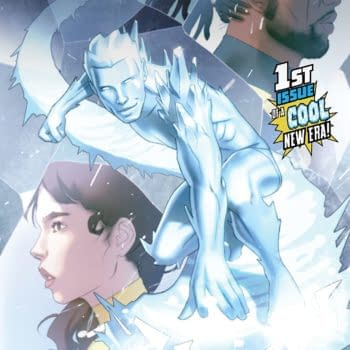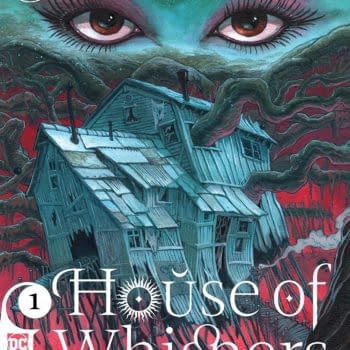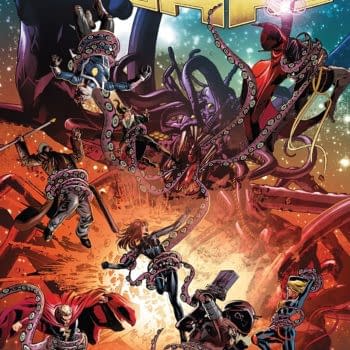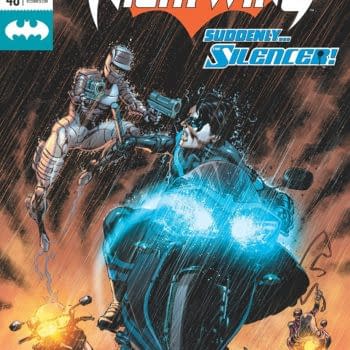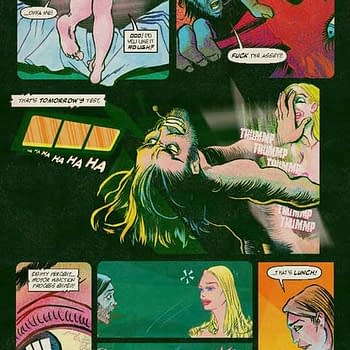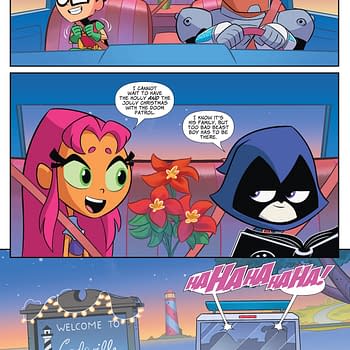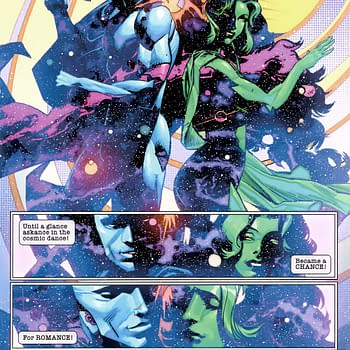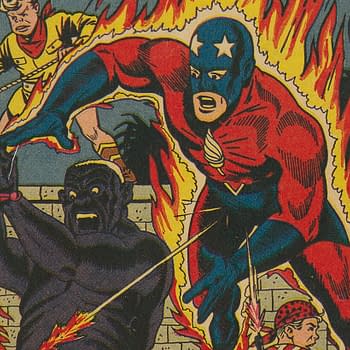Posted in: Comics, Marvel Comics | Tagged: ant man, avengers, baron zemo, fixer, heroes for hire, HRL, iron fist, kurt busiek, luke cage, mach i, mark bagley, Marvel Comics, moonstone, onslaught, songbird, spider-man, The Fantastic Four, The Incredible Hulk, thunderbolts
Josh Talks 'Thunderbolts', Part 1: In The Beginning
At last, I am getting around to devoting a series of op-ed/retro review pieces to my all-time favorite comic book series, Thunderbolts. And what better place to start than the beginning, when the Thunderbolts were created by industry veterans, Kurt Busiek and Mark Bagley.
First appearing in Incredible Hulk #449, the Thunderbolts were a mysterious new team of heroes appearing in the shadow of the apparent deaths of the Avengers and the Fantastic Four at the hands of the creature known as Onslaught (a being accidentally created by Professor Xavier and Magneto). However, these heroes were not actually dead — they instead were in a different dimension.
The Thunderbolts have weathered the years with numerous lineup changes, different leaders, and varying goals. The original team was made up of Citizen V, Meteorite, Mach I, Songbird, Techno, and Atlas. However, in reality, they were the Masters of Evil, their identities being Baron Zemo, Moonstone, the Beetle, Screaming Mimi, Fixer, and Goliath, respectively. This was a scheme on the part of Baron Zemo to earn the public's trust, gain the privileges the Avengers were allowed, and use this to take over the world.
Since then, Hawkeye, Luke Cage, the Winter Soldier, Green Goblin, Venom, Bullseye, the Swordsman, Radioactive Man, Speed Demon, the Juggernaut, Ghost, Jolt, Boomerang, Blizzard, Mr. Hyde, Hyperion, Nighthawk, and many others have passed through their ranks. Even the Red Hulk used the name for his personal squad of vigilantes, joining up with Agent Venom, the Punisher, Deadpool, Elektra, the Leader and the Ghost Rider for a short time (despite that lineup, I was not a big fan of that run). Most recently, Jim Zub and Jon Malin had the Winter Soldier recruit the originals, sans Zemo and plus the living Cosmic Cube Kobik, for his own squad of Thunderbolts; a series I have proselytized in the name of on Bleeding Cool a couple of times now.
For starters, we are going to look at their first few adventures as collected in Thunderbolts: Justice Like Lightning, which contains their first appearance in Hulk #449, a segment from the Tales of the Marvel Universe Special, their participation in Spider-Man Team-Up #7, the first four issues of Thunderbolts, and their Annual from 1997.
We'll start with their first appearance in the Hulk, then look at the Tales of the Marvel Universe, the Spider-Man Team-Up, then the Thunderbolts proper, finishing with the Annual (this actually isn't the order from the collection I'm using for reference; it's more creative with the ordering).
The story from Incredible Hulk #449 is about what you'd expect. The Hulk is just hoping around and doing his thing with his then-associate Janis when the Thunderbolts attack him. A brawl occurs, the Thunderbolts try to bring him in, and they get beaten back with the help of Hulk threatening to start a flood and Janis's assistance.
The Tales of the Marvel Universe Special consists of men in a bar reminiscing about the Fantastic Four and the Avengers, believing that these heroes are dead at the hands of Onslaught. Then they see the Thunderbolts stop a raging inferno and become heartened by the appearance of new heroes.
Their guest starring in Spider-Man Team-Up #7 involves distrust between the Web-Head and the Thunderbolts. Mach I, particularly, has some pent-up aggression from his days battling Spider-Man as the Beetle. They battle some mad scientists with a super-powerful battle robot and something called the "Bio-Modem," which causes people to go mad and fight one another. It's up to the team and Spider-Man to work together to bring these madmen down.
The first issue of the Thunderbolts proper sets up the world this team is entering into. The Avengers and the Fantastic Four are gone. Supervillains are running rampant in their absence. Hope is disappearing from the world. The part of New York where the battle with Onslaught occurred is still in ruins. A criminal group called the Rat-Pac are ransacking the ruins and kidnapping the survivors. Thankfully, the Thunderbolts take the scene and break up their operations. However, some escape and recruit the Wrecking Crew. It turns into a no-holds-barred battle between the Wrecking Crew and the Thunderbolts for the future of New York. The Thunderbolts also form a connection with Dallas Riordan, who was, at the time, a representative of the U.S government focusing on dealing with superhumans.
The second issue goes more into who the Thunderbolts really are as they deal with Riordan and an attack from the Mad Thinker's Awesome Android. They manage to stop the Android and take the fight to the Thinker himself. Unfortunately, the Thinker they find turns out to be an android himself, leaving the Thinker's whereabouts and future plans a mystery. They are, however, able to establish a headquarters at the former home of the Fantastic Four: Four Freedoms Plaza.
The third installment finds the Thunderbolts fighting off a new iteration of the Masters of Evil led by the mysterious Crimson Cowl. They are unable to capture this team, and they come under the scrutiny of the Black Widow. She is very suspicious of the Thunderbolts. This issue ends with a teenaged girl dressed in a torn hospital gown infiltrating Four Freedoms, and the girls displays the power to emit electricity to dangerous effects.
The following issue, the Thunderbolts learn who this girl is. She is Hallie Takahama, and she was kidnapped by the Rat-Pac and taken to Arnim Zola. With a now-uniformed Hallie in tow, the Thunderbolts track down Zola and fight an army of his monster men. They shut down his operation, but Zola still escapes. Zemo/Citizen V finds it to be a profitable proposition to recruit Hallie, and she accepts. She becomes the newest Thunderbolt, Jolt!
The Annual goes into the origins of the Thunderbolts, how Zemo came up with this plan, how he recruited the other five members, and how he knew to seize the opportunity of Onslaught. It also shows his concerns about the growing altruism in his team and the connections he is building between the Thunderbolts and the U.S government. Meanwhile, Jolt becomes very attached to both Zemo/Citizen V and Atlas/Goliath.
Yes, the early days of the Thunderbolts were still rather caked in the decade in which they originated. The 1990s show their ugly head in some of the dialogue, but especially in the art.
That being said, the stories still elevate themselves above this otherwise fatal flaw. The characters are interesting and diverse. Songbird has major confidence issues and is unsure of her place in the world. Atlas is a bit of a brute who wants to be more than that. Moonstone is a manipulative witch who will do anything to be on the winning side. Mach I is unsure of his own identity, but he knows he feels proud of his time in the Thunderbolts. Fixer is unable to elevate himself above being Zemo's lackey and is ready to turn on his teammates at a moment's notice. Zemo is a megalomaniac with confidence issues of his own who is willing to manipulate and take advantage of all of this to meet his terrible goals.
It's an interesting scheme, to become superheroes to earn the world's trust. They model themselves after their enemies to take advantage of the privileges they receive. There is even a bit of satire in that idea, especially in the fact that they attempt to get access to government files that were freely given to the Avengers, a then-wholly private organization.
Mark Bagley's art is definitely among the best in the collection; this guy is a well-respected industry vet for a reason. He knows how to play with shapes and settings; he can make an interesting costume and an eye-catching venue for a brawl.
The overall color work is less successful. While the Hulk issue looked good, much of the trade is oversaturated with bright colors and pale shades, which result in far too many lighter colors on the page with nothing allowed to stick out.
That being said, this bout of Thunderbolts adventures was stellar. The characters were engaging. The episodic plots were simplistic but useful to the development of the over-arching tale. Bagley and Deodato, who does some of the pencil work too, keep the art steady. I would highly recommend this trade to anyone.
More recently, a different collection of stories from the first volume of the Thunderbolts was released, called Thunderbolts Classic. It has the same issues but with #5 in addition. It's priced at about $35, which is admittedly pricey and a big inflation from the MSRP of the one I have. I still recommend it, though, if you have the scratch.
I'm not sure where I will be going from here. I may move onto Thunderbolts Classic Vol. 2, the first volume of Fabian Nicieza's New Thunderbolts, or I may spotlight the entirety of Jim Zub's Thunderbolts series from this past year (in the hopes that more may be printed later on). Leave your suggestions in the comments, if you'd like.
Until next time!







